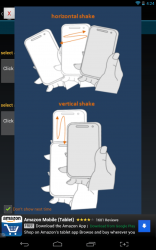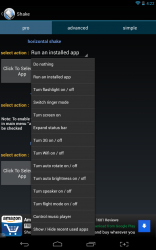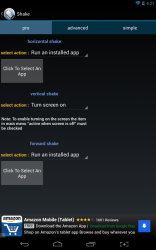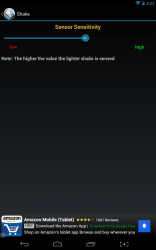 Probably one of the coolest features of modern smartphones is the accelerometer, which allows them to detect motion and tilt. Of course, the detection system requires more than just that one component, but that’s not what we’re going to focus on. It’s used for a lot of different things, like rotating the screen, serving as a unique controller and more. With Shake for Android, you can also use the sensor to call upon installed apps or perform various functions. For example, you can shake your phone in a horizontal pattern to turn off the screen, or start an application like Facebook.
Probably one of the coolest features of modern smartphones is the accelerometer, which allows them to detect motion and tilt. Of course, the detection system requires more than just that one component, but that’s not what we’re going to focus on. It’s used for a lot of different things, like rotating the screen, serving as a unique controller and more. With Shake for Android, you can also use the sensor to call upon installed apps or perform various functions. For example, you can shake your phone in a horizontal pattern to turn off the screen, or start an application like Facebook.
What is it and what does it do
Main Functionality
 Probably one of the coolest features of modern smartphones is the accelerometer, which allows them to detect motion and tilt. Of course, the detection system requires more than just that one component, but that’s not what we’re going to focus on. It’s used for a lot of different things, like rotating the screen, serving as a unique controller and more. With Shake for Android, you can also use the sensor to call upon installed apps or perform various functions. For example, you can shake your phone in a horizontal pattern to turn off the screen, or start an application like Facebook.
Probably one of the coolest features of modern smartphones is the accelerometer, which allows them to detect motion and tilt. Of course, the detection system requires more than just that one component, but that’s not what we’re going to focus on. It’s used for a lot of different things, like rotating the screen, serving as a unique controller and more. With Shake for Android, you can also use the sensor to call upon installed apps or perform various functions. For example, you can shake your phone in a horizontal pattern to turn off the screen, or start an application like Facebook.
Pros
- Allows you to choose actions or apps to be activated by verious shaking motions
- There are three movement patterns to use and assign
- Horizontal shake
- Vertical shake
- Forward shake
- Not too heavy (but not extremely light) on system resources (29MB of RAM usage)
Cons
Discussion
The concept is ingenious really. In my opinion, it’s one of the best things Apple implemented in their iPod and iPhone devices. On most of those, you can shake the device while playing music to shuffle, or skip tracks. It’s a simple feature, but it’s both incredibly useful and convenient. It works even when the screen is off, and allows you to interact with the device(s) without pressing any buttons.
Shake takes that same concept, and applies it to Android devices on a much grander scale. There are three different motions you can use to call upon various apps or actions.
- Horizontal- shake the device back and forth
- Vertical- shake the device up and down
- Forward- lower the device and pull it forward
 When you first load the app, you will be presented with the main menu. The topmost option allows you to choose various actions for the different shake patterns. Below that in respectful order is the following:
When you first load the app, you will be presented with the main menu. The topmost option allows you to choose various actions for the different shake patterns. Below that in respectful order is the following:
- Sensor sensitivity
- Service state- enable or disable
- Start at phone boot- enable or disable
- Active when screen is off (uses more battery)- enable or disable
- Vibrate when shaken- enable or disable
- Notify when shaken- enable or disable
The aforementioned settings are pretty straightforward. When you choose the top option to customize the associated actions and shake patterns you are brought to yet another menu. This subsequent menu is separated into three tabs: pro, advanced and simple. Simple includes configuration options for a simple shake, advanced includes configuration options for a horizontal or vertical shake, and pro includes configuration options for horizontal, vertical and forward shakes. Essentially, they are ordered by trigger difficulty.
 You can assign an action, or an app to any of the shake patterns. Instead of running through the entire list of actions you can assign, just believe me when I say it’s comprehensive. If you really want to see the complete list before installing, visit the Play Store link included below as it’s in the app’s description.
You can assign an action, or an app to any of the shake patterns. Instead of running through the entire list of actions you can assign, just believe me when I say it’s comprehensive. If you really want to see the complete list before installing, visit the Play Store link included below as it’s in the app’s description.
On my device the power on and off button is worn down, because I use it so much. Naturally, I have the application set to turn on my screen when I shake the device in a vertical pattern. This allows me to forego using the power button to turn on the screen, and adversely I can leave it untouched until the screen turns off. Ultimately, I no longer need to call upon the button at all. In order to do this, however I had to enable the “active when screen is off” function.
The service (app) needs to remain running in the background in order for the shake commands to work properly. As I mentioned above, if you want it to work when the screen is off the related option also needs to be enabled. It definitely works as advertised, and does a great job at registering the various shake commands.
For reference, Shake uses nearly 29MB of RAM while running. Luckily, since the app runs continuously in the background, the resource usage is acceptable and low enough to be considered relatively light.
Conclusion and download link
 Shake is a free Android application that allows you to use various shake commands and movement patterns to call upon various actions or run installed apps. It’s customizable, which means there are a few different ways to use it. Do you want the screen to turn on after a horizontal shake? Do you want to launch the camera after a forward shake? Shake can do all that. It does need to run continuously in the background in order to register the movement patterns, but it’s not too bad on system resources (29MB of RAM). It’s a great way to add some advanced controls to your device, and it works just as advertised. I definitely recommend giving this one a try.
Shake is a free Android application that allows you to use various shake commands and movement patterns to call upon various actions or run installed apps. It’s customizable, which means there are a few different ways to use it. Do you want the screen to turn on after a horizontal shake? Do you want to launch the camera after a forward shake? Shake can do all that. It does need to run continuously in the background in order to register the movement patterns, but it’s not too bad on system resources (29MB of RAM). It’s a great way to add some advanced controls to your device, and it works just as advertised. I definitely recommend giving this one a try.
Price: Free
Version reviewed: 1.6
Requires: Android 2.3 and up
Download size: 576KB

 Email article
Email article




